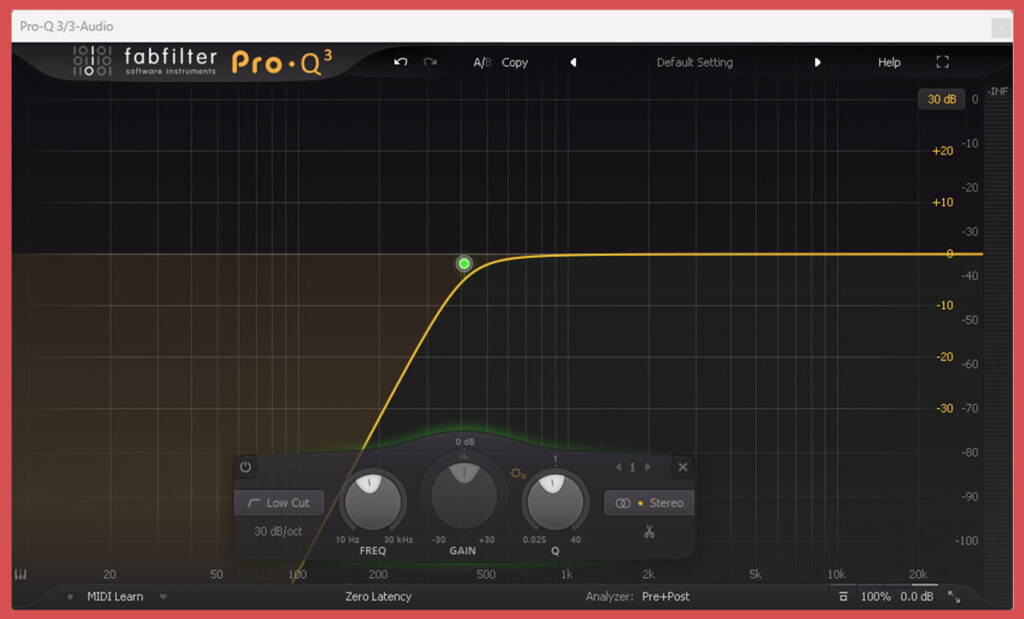What is a high pass filter/low cut filter?
A high-pass filter is a type of equalizer that attenuates or completely suppresses frequencies below a certain cutoff frequency (Cutoff Frequency), while allowing frequencies above the cutoff frequency to pass through unchanged. There are two different names for high-pass filters, both of which essentially explain the function of the filter and have the same meaning:
- High pass filter: The high frequencies "pass", i.e. they are let through.
- Low cut filter: Low frequencies are "cut", i.e. attenuated or removed.
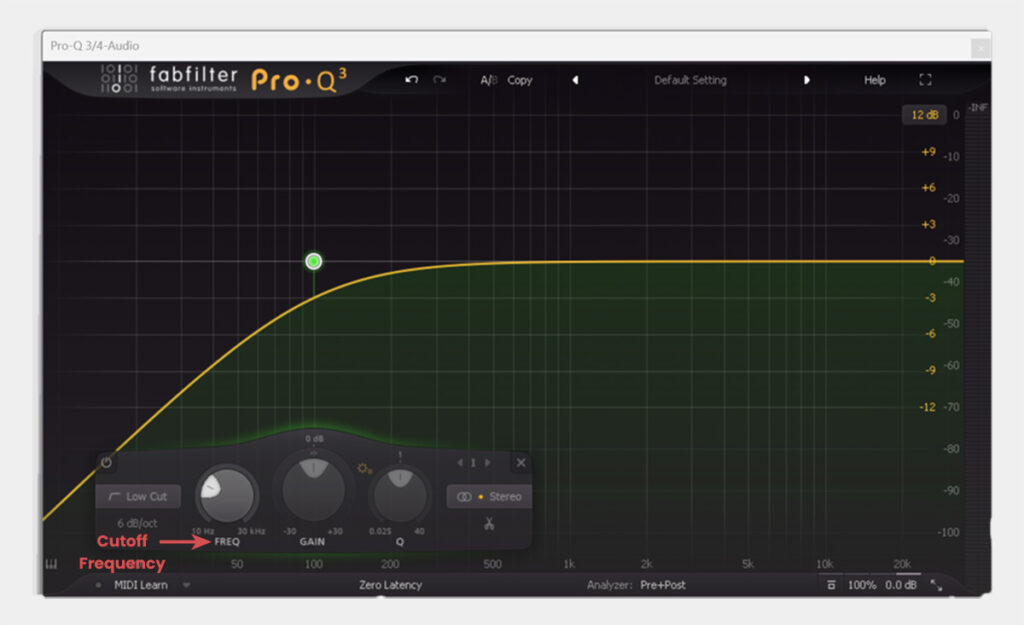
This cut-off frequency can be fixed or flexible, depending on the filter. Many audio interfaces and Preamps have a built-in high-pass filter whose frequency cannot be changed.
Hardware and plug-in EQ low-cut filters, on the other hand, allow you to adjust the cutoff frequency, as well as the intensity/curve slope, which indicates how much dB is cut. High-intensity high-pass filters sound more unnatural and can cause phase problems, so they should always be used with care.
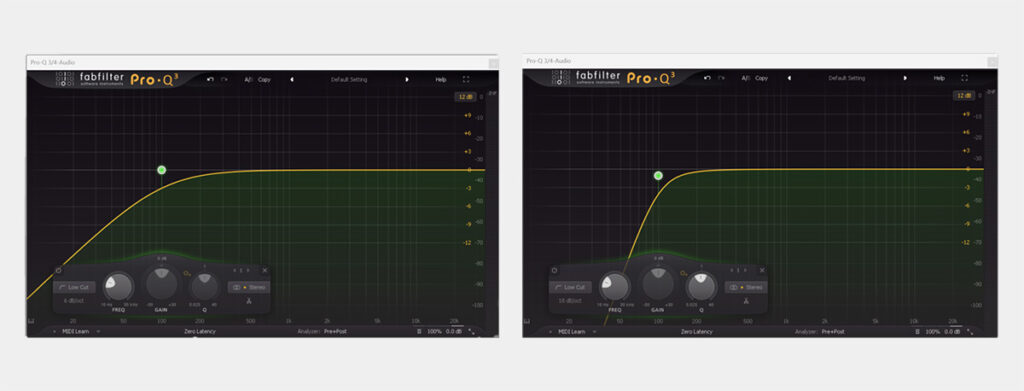
It is expressed in dB/octave and indicates how much the low-cut filter attenuates at half the cut-off frequency. For a low-cut filter of -18 dB/octave at 100 Hz, as in the example above, the attenuation at 50 Hz is -18 dB.
Depending on the steepness of the curve, the filters are given different names, such as those used in synthesizers and analogue effects.
| 6 dB/oct. | Low cut filter 1st order | 1-pole filter |
| 12 dB/oct. | Low cut filter 2nd order | 2-pole filter |
| 18 dB/oct. | Low cut filter 3rd order | 3-pole filter |
| 24 dB/oct. | Low cut filter 4th order | 4-pole filter |
| 30 dB/oct. | Low cut filter 5th order | 5-pole filter |
| ∞ dB/Oct | Brickwall filter |
Higher-order high-pass filters should be used for corrections such as noise reduction or as creative effects, as in DJ controllers. The reason is simple: they are very audible and sound unnatural, and can easily ruin vocals.
For example, I often use a 5th-order low-cut filter at 50 Hz on female vocals to suppress unwanted ambient noise, such as footsteps or bumps on the mic stand, because I know the voice is not playing in those low frequencies.
But I would never use it to make the voice thinner at 250 Hz, for example, because it doesn't get thinner, it almost disappears. A 1st order high-pass filter is much better for that.
Most EQ plugins allow you to select the strength/order of the filter. On analogue units that do not offer this, it is usually 12dB/octave.
What are high-pass filters used for?
High-pass filters are often used in analogue equipment such as preamps, audio interfaces or microphones to suppress noise in the lower frequency range. There are many situations in the studio where such noise occurs:
- If the floor is wooden and somewhat old (as in my studio), the artist's walking or moving can cause vibrations in the floor that are transmitted to the stand and thus to the microphone. These sound waves are in the low frequency range and can be very easily reduced or eliminated with a high pass filter.
- Power line hum can cause artefacts in the lower frequency range, especially if the entire system is not properly electrically shielded.
- If the studio is not well shielded from the outside world, large vehicles such as trucks or buses can produce deep sound waves that can get into the microphone.
- If the singer accidentally bumps the mic stand, this noise can sometimes be suppressed with a high-pass filter (sometimes not).
However, I always prefer to use my low-cut filter as a plugin in post-production rather than during recording, as it allows me to remove these frequencies non-destructively - there may still be something of value in that frequency range.
Even if you think you have no noise in the audio track, listen carefully to what happens when you apply a high-pass filter - you may be surprised at how clean the track suddenly sounds.
In general, it makes sense to apply a low-cut filter to 'safe' tracks (i.e. instruments that tend to play in the high frequencies, such as hi-hats, guitars or female vocals), as there is no information in the low frequencies anyway, only noise. This leaves room for the important low frequency tracks such as kick and bass, and the mix becomes much clearer and cleaner.
Low cut filters are also often built into the sidechain signal of compressors so that the low frequencies, which often contain no important information, do not overload the compressor and only the important high frequencies make the compressor work.
High pass filter vs low pass filter
High-pass and low-pass filters are two types of electronic filters that change the frequency response of a signal. Although their names sound similar, they have completely opposite functions. The main difference is which frequencies they let through and which they block.
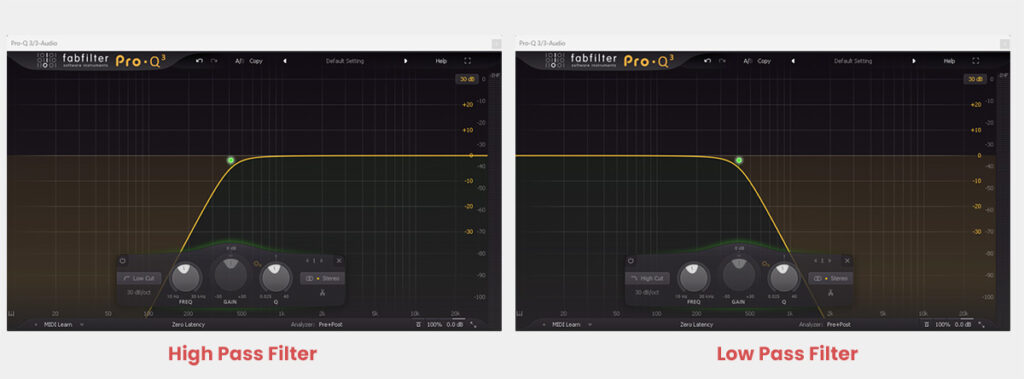
A high-pass filter allows high-frequency signals to pass through while attenuating or blocking low-frequency signals. High-pass filters are typically used to remove unwanted low-frequency noise or DC components from a signal.
In contrast, a low-pass filter allows low-frequency signals to pass, while high-frequency signals are attenuated or blocked. Low pass filters are often used to suppress unwanted high frequency noise (hiss) or to smooth a signal by removing or reducing high frequency components.
Practical applications of a high-pass filter
As already mentioned, the use of a high pass filter is often aimed at removing unwanted noise and artefacts. If you have the option, I would only use the low-cut filter in post-production to be on the safe side. In a live situation, of course, this is not possible, so use the high-pass filter built into each channel strip of the mixing console.
It is recommended that you use the high pass filter before the compressor - in fact, it should be the first effect in the signal chain. Because low-frequency sound waves carry a lot of energy, they can quickly push a compressor to its limits, even though the higher-frequency signal you want to compress has not yet crossed the threshold.
Here are some examples of low cut filter applications that are part of every music producer's everyday life:
High-pass filter for clean vocals
High-pass filters are often used as the first effect unit on vocals to achieve a clean, noise-free track. It also allows you to handle dynamics much more effectively, preventing low frequency sound waves from unnecessarily overloading the bass end of the mix.
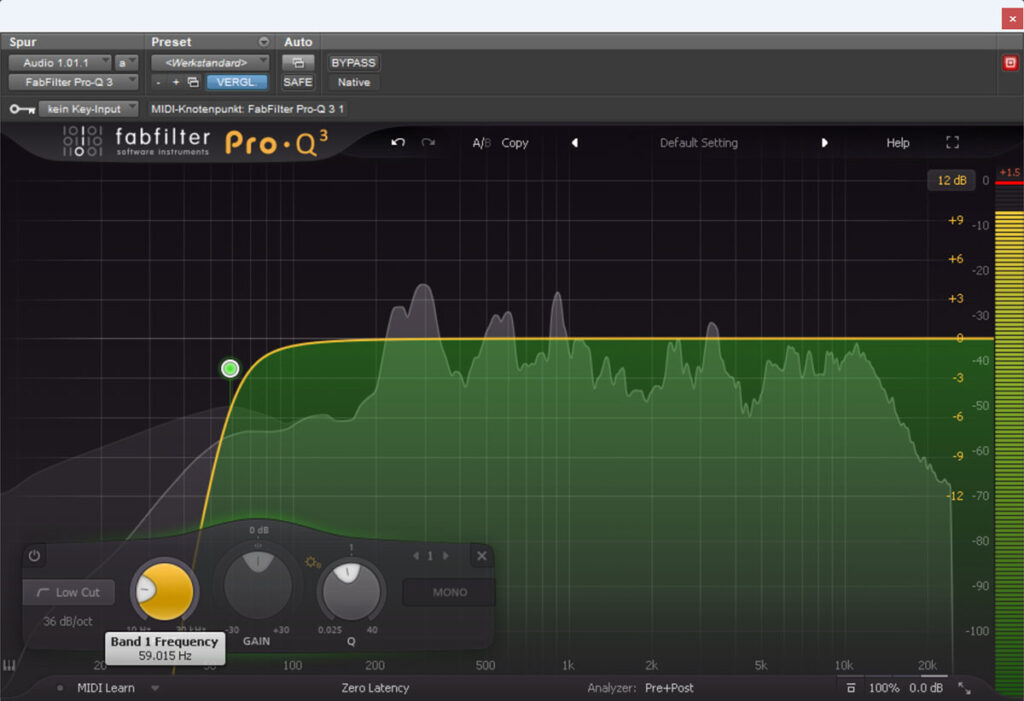
The trick is to find out where the highest possible cut-off frequency is without losing important information in the voice. Once you have found that, you can also use low-cut filters with a higher slope to completely suppress anything below that frequency.
High-pass filter on the overheads to avoid phase problems with the bass drum track
When recording a real drum kit with multiple microphones, there is often a danger that the combination of kick and overheads will cause phase problems. This is simply because the same wave (kick) arrives at two different microphones, but in different phases because of the different distances to the microphones (the kick microphone is practically in front of the bass drum, while the overheads are about 1m away).
A high-pass filter on the overhead channels can solve this problem. However, the kick will no longer be heard on the overhead channels. This is not necessarily a bad thing, and sometimes it is even desirable if you want the kick to sound like it is right in front of you.
So always listen carefully to see if a low-cut filter is needed at all. Listen to what happens when you mix the two tracks together: Are frequencies cancelled out? Does the kick suddenly sound strange or unpleasant? Then you probably have phase problems.
High-pass filter for compressor sidechain signals
Compressors often offer the option of applying a low-cut filter to the sidechain input signal. This does not affect the audible signal, only the control signal. This prevents unwanted low frequencies from making the compressor work, and only the really important frequencies trigger the compressor.
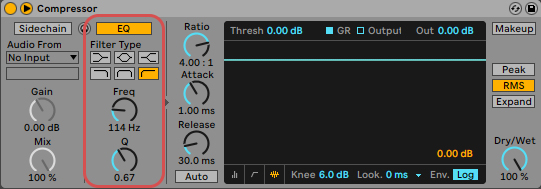
This is particularly important for mastering, as the low frequencies of a master track are often louder than the high frequencies. Remember that a compressor always kicks in when the volume of the source material exceeds the compressor's threshold.
A high threshold means that if no low-cut filter is used, the compressor will only compress the low frequencies, as these are the loudest and will cause the compressor to work first. If you then lower the threshold to compress the high frequencies as well, the bass frequencies will be compressed to such an extent that the track will sound completely unnatural and squashed.
However, if a high-pass filter is used, the low frequencies cannot cause the compressor to work because they are simply ignored. It is only when the level of frequencies above the low-cut filter exceeds the threshold that the compressor starts to work.
Use of low cut filters to suppress sound of steps
As already mentioned, it often happens during recordings that walking or stepping causes vibrations in the floor, which then enter the microphone. With a low-pass filter, this "step sound" and vibration can be effectively suppressed or even eliminated.
Conclusion
You now know what a high-pass filter is and how to use it in theory. Now you need to practice and gain experience. And remember: Always trust your ears, not your eyes. Sometimes high-pass filters are too extreme and other types of filters, such as shelving filters, are more appropriate.





